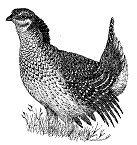Papers in the Biological Sciences

Papers in Ornithology
Document Type
Article
Date of this Version
July 1988
Abstract
0NE OF THE rewards for braving the remnants of a Nebraska winter by venturing out to newly thawed reservoirs, lakes and sandpits is the prospect of seeing a flock of common goldeneyes. Hard on the heels of winter, goldeneyes begin moving out of their wintering areas in the central and southern Great Plains and testing the waters to the north as as they become partially ice-free. Fair numbers of birds, sometimes in the thousands, often winter in western Nebraska, especially along the North and South Platte rivers, and in adjoining areas of eastern Wyoming and Colorado, but very few winter in eastern portions of the state. But by early March they make their presence known in wetlands along the Missouri Valley, where the mostly white males stand out in flocks of other early migrant waterfowl like proverbial sore thumbs. They are substantially larger than the somewhat similar and closely related bufflehead, and not so long and rakishly streamlined as the common merganser, although all three of these species commonly are seen together during early spring in Nebraska. But a mostly white-bodied duck, with a large blackish (under cloudy conditions) to green-glossed (in sunlight) head, save for an oval white spot between the eye and bill, can be confidently identified as a common goldeneye. Rarely, the more westerly Barrow's goldeneye appears in Nebraska, but males of this species have a distinctive white crescent in front of the eye, and the head appears to glossed with blue or violet.


Comments
Published in NEBRASKAland, 66:7 (1988), p. 50. Used by permission.